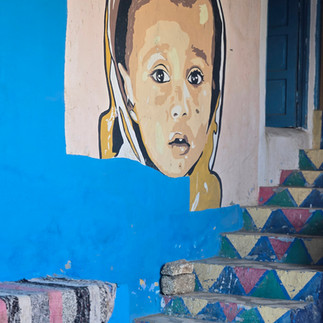An Artist's Journey (Part Two): Cruising the Nile to Aswan and Abu Simbel.
- Marjorie Vernelle

- Jan 9
- 8 min read


It seems that Ramesses II wanted to commemorate two special dates in his life: his birthday and the day he became king. The first is February 21, and the second is October 21. His temple at Abu Simbel was designed to allow the rising sun (remember that Ramesses means "the son of the sun") to come directly into the temple to light up three of the four figures seated at the very back. Ramesses sits in the middle between Amun and Ra. The figure to the far left in the dark is Ptah, the Creator, who creates with the word. His first word, by the way, was "Light." So on those special days each year now, which over the centuries have moved to February 22 and October 22, at dawn, with hundreds of eager tourists, cameras ready, the sun pierces the darkness of the temple to light up the three seated figures, and of course leave Ptah in the darkness from which he comes. This October, I arrived from Aswan with my tour group (two lovely French couples who were in all of the tours provided by the cruise we were on) on the 20th of October around 8:00 in the morning to get this shot. It is not yet as properly aligned as it would be on the 22nd, but you can see the sunlit figures. Best of all, we five were the only ones there and had the temple to ourselves for about 15 minutes before other tour groups arrived.

The temple of Ramesses II shows mostly his ability to conquer others. By the way, sadly some documentaries and tourists' videos focus only on a wall at the entrance to the temple that shows African captives from Cush, without turning around to look at the opposite wall of Levantine and Libyan captives. Ramesses, like other pharaohs, was an equal opportunity oppressor for the greater glory of Egypt. However, the companion Temple of Hathor, shows a different side of this king. On the exterior the figures of the king (4 of those) and the figures of his Great Royal Wife (2 of those) are the same height. The inside of the building is, in fact, delightful and shows a balance of male and female energy. Unfortunately, at the far end of the temple, the image of the two of them coming together as a unit that works both energies in consort has been damaged, because it was covered in gold. That gold was stripped off in ancient times, leaving the figures unrecognizable. However, it seems that the structure of the temple has mostly images of her on the left side and mostly his image on the right side in an attempt to show a balance of male and female energy.
Interestingly one can see tall figures of Nefertari standing behind Ramesses as he is beating the "enemies." Her moral support was important to him. In fact, after the Hittites made an attempt to kidnap her (a lady of the court noticed two suspicious chararacters on the palace grounds and called the guards), he carried her with him when he went on military campaigns It was also Nefertari who brokered the peace treaty between the Hittite Empire and Egypt by writing to the Hittite queen to suggest that they send a princess for the pharaoh to marry and let their families be joined in marriage. Her advice to Ramesses once the offer arrived was to marry the princess and make peace. From that came the first known written peace treaty between two great powers. A copy of it is in the United Nations in New York City. And what was Ramesses' comment about this temple: "I, Ramesses, beloved of Amun, have created this delightful temple for my royal wife Nefertari, whom I love." On one of the buttresses, it is written that she is the one "for whom the very sun does shine." Nice work if you can get it.

The area around Aswan is full of cultural wonders that relate to what has become known as Nubia. The word itself is a latinized play on the ancient Egyptian word for gold (nub or nob): Nubia, Land of Gold. The ancient Egyptians actually referred to the lands to the south (modern southern Egypt, northern Sudan) as Ta-Seti, the Land of the Bow, for the famous Medjay warriors who were so skilled in archery. Ta-Seti, which from 3800 - 3100 BCE was its own land, then became a Nome (administrative distict) of ancient Egypt. To this day, though they are all Egyptians, and quite often in shades of brown skin, those with broader features are considered Nubian, though some have finer features but dark skin as seen in Ethiopia and Somalia (parts of ancient Punt). Since the civil war in Sudan started in April 2023, Egypt has taken in 1.2 million Sudanese refugees. Not all of them, of course, live in the south or feel themselves to be Nubian, which is a very specific culture in its own right, of which the Nubian people are proud. They have their own language and music, which I was treated to on a boat trip back to Aswan from a visit to a Nubian village.
As can be seen in the pictures above, the Nubian culture values color. A visit to a Nubian village allows one to see how they decorate their homes in vibrant colors, wall paintings, and such. Often they even have a pet crocodile. The merchants have wonderful spices on display, and some of the people have gone into the business of having guest houses along the banks of the river. While I stayed in Aswan for a couple of days after my river cruise, my French companions stayed in Nubian guest houses on Elephantine Island. I wasn't to get Nubian architecture again until my stay in Hurghada at the Arabella Azur Resort, which is all in Nubian style architecture.


While some trips can only be made by camel, I tended to stick to the river as on the way to Philae Island, where the Temple of Isis is located. The creation of the Aswan High Dam meant that more than just Abu Simbel had to be lifted up above the waters of the newly created Lake Nassar. The temples of Philae Island were saved by moving them to a new location. The new location is a wonderful fresh air ride up river in an area of swift currents and many rock outcroppings (the first cataract). However anything north of the dam means there are no crocodiles. But say a prayer to Sobek the Crocodile God if you want to take a Nile swim near Abu Simbel, as that is south of the dam where the crocodiles still exist. Below, a ride to Philae with our wonderful guide Omar Khasty and my French companions from the cruise.


A trip to Philae is a delight whether for the boat ride, the views of the rock formations, or just the beautiful temple. The temple complex was done by Ptolemy II and Ptolemy III in the 3rd centrury BCE. However, some of the structures on the original island of Philae, which was a site for the worship of Isis, were done in the 7th century by Cushite pharaoh, Taharqa. His work was followed by that of various Saite kings a bit later in that century. Nectanabo I built a hall, and Nectanabo II (the last independent Egyptian pharaoh) built a colonnade which still stands. Those are from the 4th century BCE. Though the temple complex is no longer on Philae Island because of the flood waters from the High Dam, its current location gives one the idea of its majesty, especially when seen from the river.
As mentioned in my previous article, the part one of this journey, Egypt has a lot to offer any visitor. There are modern cities with great museums, ancient sites from north to south, and resorts on the Red Sea. Of course, do not forget to ride the river - it's historic and fabulous!
For those who are thinking of making their own trip to the "Gift of the Nile" as Herodotus once called Egypt, I have some excellent guides for you.
Here is the A-team: Mahmoud Ali (Luxor), Omar Kashy (Aswan), the Two Mohammads (Luxor)
Mahmoud Ali is an Egyptologist (University of Cairo) who, when not working on a dig, gives excellent tours of the Valley of the Kings, Hatsepshut's Temple, and the Temples of Karnak and Luxor. He was the guide who provided us with excellent information when working with the tour I had with the House of Life. As well, his family does wonderful prints of ancient Egyptian images on really finely made papyrus.
Omar Kashy works in Aswan and knows so much about the area, the historical sites, the Souk, and museums. He has quite a network of people who can help you go wherever you want to go, including providing a good driver if you wish to hop around Aswan to see multiple things or just get to the airport. Between working as an expert guide, he is a real estate agent - just in case you fall in love with Aswan and its Nubian surroundings. I really appreciated his help.
Last but not least, are my three favorite Mohammads (I have no photo of the third Mohammad from Full Moon House). In the photo above the one on the left is a fabulous driver, in Luxor traffic no less, and the one on the right (Madu) is a graduate in Egyptian History from University of Cairo. He helped me search bookstores looking for art books on ancient Egyptian art, took me through both the ordinary souk in Luxor and the Old Luxor Market, where one finds carpets, alabaster, copper items, papyrus, and other exotic pieces. I had the good fortune of having lunch with these two, who are childhood friends, and they taught me about Egyptian food and how to eat it to get the full enjoyment of a wonderful cuisine. All this was followed by a visit to HUU Nature Shop, where its Egyptian essential oils have now become my very favorites.
Above is Full Moon House in West Luxor. It overlooks the Nile and has a beautiful rooftop terrace. A meal of fresh fish is on the menu, so you can order your food from their menu (the view is of the lighted temples of Luxor and Karnak across the Nile). Finally, some wonderful laterns from the Souk in Old Luxor.

If you want to contact any of these great guides, just let me know at vernellestudio@gmail.com Or send an email from inside the Contact page here on VernelleStudio.
For Full Moon House, info and photos:
Egypt awaits your visit! The pharaohs will be pleased to see you.
If you have more interest in ancient Egypt, take a look at my novel on Pharaoh Seti I, Temple in the Sand: The Memoirs of a Pharaoh on Amazon.com and at Barnesandnoble.com
© Marjorie Vernelle 2024





















Comments